Abstract
Larvae of Pleurodeles poireti were maintained during their development at a high temperature (31° C). In several species of amphibians, such a treatment is known to change the sex ratio through the inversion of genotypic females into phenotypic males. Pleurodeles poireti is an exception. It is the first reported amphibian in which heat induces an inversion of genotypic males into functional phenotypic females. The sexual genotype of standard and experimental phenotypic females was determined through heterochromosomes in lampbrush stage. In the present study, we have utilised another technique for identification of sexual genotype, applicable to both phenotypic males and females. It is based on the differential expression of a sexlinked gene, the peptidase 1.
Similar content being viewed by others
References
Collenot A (1973) Obtention, par la méthode des greffes de gonades embryonnaires, d'une femelle à descendance unisexuée femelle, chez le triton Pleurodeles waltlii Michah. Experientia 29:885–887
Collenot A (1975) Unisexual female offsprings in the salamander Pleurodeles waltlii Michah. In: R Reinboth (ed) Intersexuality in the animal kingdom. Springer Verlag, pp 311–317
Dournon C (1981) Action d'une température d'élevage de 30° C sur la morphogenèse, l'inversion fonctionnelle du phénotype sexuel et la prolifération des cellules germinales chez l'Amphibien Urodèle Pleurodeles waltlii Michah.. Thesis Doc Etat Sci Nat Univ P et M Curie, 204 p
Dournon C, Houillon Ch (1983) Déterminisme génétique du sexe: démonstration à partir d'animaux à phénotype sexuel inversé sous l'action de la température chez l'Amphibien Urodèle, Pleurodeles waltlii Michah. CR Acad Sci Sér III, 296:779–782
Ferrier V, Jaylet A, Cayrol C, Gasser F, Buisan JJ (1980) Etude électrophorétique des peptidases érythrocytaires chez Pleurodeles waltlii (Amphibien Urodèle): mise en évidence d'une liaison avec le sexe. CR Acad Sci Sér D, 290:571–574
Ferrier V, Gasser F, Jaylet A, Cayrol C (1983) A genetic study of various enzyme polymorphisms in Pleurodeles waltlii (urodele amphibian). II-peptidases: demonstration of sex linkage. Biochem Genet 21:535–549
Foote CL (1964) Intersexuality in amphibians. In: Armstrong CN, Marshall AJ (ed) Intersexuality in vertebrates including man. Academic Press, London, New-York, pp 233–272
Gallien L (1951) Sur la descendance unisexuée d'une femelle de Pleurodeles waltlii Michah. ayant subi pendant sa phase larvaire l'action gynogène du benzoate d'oestradiol. CR Acad Sci 233:828–830
Gallien L, Durocher M (1957) Table chronologique du développement chez Pleurodeles waltlii Michah. Bull Biol Fr Belg 91:97–114
Houillon Ch, Dournon C (1978) Inversion du phénotype sexuel femelle sous l'action d'une température élevée chez l'Amphibien Urodèle, Pleurodeles waltlii Michah. CR Acad Sci Sér D 286:1475–1478
Hsü CY, Yü NW, Liang HM (1971) Induction of sex reversal in female tadpoles of Rana catesbeiana by temperature treatment. Endocrinol Jpn 18:243–251
Lacroix JC (1968) Variations expérimentales ou spontanées de la morphologie et de l'organisation des chromosomes en écouvillon dans le genre Pleurodeles (Amphibien, Urodèle). Ann Embryol Morphol 1:205–248
Lacroix JC (1970) Mise en évidence sur les chromosomes en écouvillon de Pleurodeles poireti Gervais, Amphibien Urodèle, d'une structure liée au sexe, identifiant le bivalent sexuel et marquant le chromosme W. CR Acad Sci Sér D 271:102–104
Lacroix JC, Loones MT (1974) Sélection par les chromosomes en écouvillon de lignées vectrices de mutations chez l'Amphibien Urodèle Pleurodeles poireti. Chromosoma 48:297–326
Lewis WHP, Harris H (1967) Human red cell peptidases. Nature 215:351–355
Piquet J (1930) Détermination du sexe chez les Batraciens en fonction de la température. Rev Suisse Zool 37:173–281
Uchida T (1937) Studies of the sexuality of amphibia. III. Sex transformation in Hynobius retardatus by the function of high temperature. J Fac Sci, Hokkaïdo Imp Univ, Ser 6 (Zool) 6:59–70
Witschi E (1914) Experimentelle Untersuchungen über die Entwicklungsgeschichte der Keimdrüsen von Rana temporaria. Arch Mikrosk Anat Entwicklungsmech 85:9–113
Witschi E (1929) Studies on sex differentiation and sex determination in amphibians. II. Sex reversal in female tadpoles of Rana sylvatica following the application of high temperature. J Exp Zool 52:267–291
Wright DA, Huang CP, Chuoke BD (1976) Meiotic origin of triploidy in the frog detected by genetic analysis of enzyme polymorphisms. Genetics 84:319–332
Yoshikura M (1959) The action of the pituitary in sex differentiation and sex reversal in amphibians. II. Effects of high temperature on the gonads of hypophysectomized frog larvae. Kumamoto J Sci Ser B Sec 2, 4:69–101
Author information
Authors and Affiliations
Rights and permissions
About this article
Cite this article
Dournon, C., Guillet, F., Boucher, D. et al. Cytogenetic and genetic evidence of male sexual inversion by heat treatment in the newt Pleurodeles poireti . Chromosoma 90, 261–264 (1984). https://doi.org/10.1007/BF00287033
Received:
Issue Date:
DOI: https://doi.org/10.1007/BF00287033




